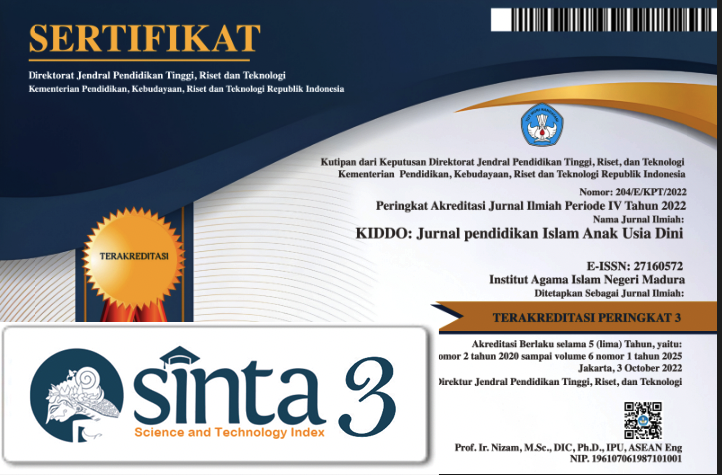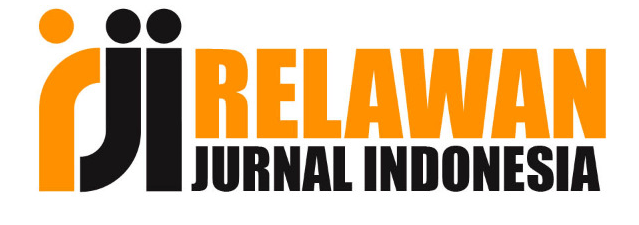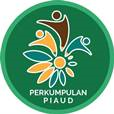Program Pemberian Makanan Tambahan dalam Pencegahan Stunting Pada Anak Usia Dini di TK Fathina Majene
 Abstract views: 145
,
Abstract views: 145
,
 PDF downloads: 227
PDF downloads: 227
Abstract
This research evaluates the effectiveness of the Supplementary Feeding Program (PMT) in preventing stunting in early childhood at Fathina Majene Kindergarten, Majene Regency, West Sulawesi. This research uses a qualitative approach with a case study design, data was collected through participant observation, in-depth interviews and document analysis. The research results showed that the PMT program at Fathina Majene Kindergarten was effective in improving children's nutritional status, with an average increase in body weight of 10-15% and height of 5-7% after six months of implementation. The risk of stunting was also reduced by 30% in the group of children who participated in the program. This success is influenced by the consistency and quality of additional food, active involvement of teachers and parents, as well as support from local health agencies. In addition, positive changes in children's eating behavior and increased parental nutritional awareness also contributed to the success of the program. In conclusion, the Supplementary Feeding Program at Fathina Majene Kindergarten shows promising potential in improving nutritional status and preventing stunting in early childhood.
Downloads
References
Aboagye, R. G., Seidu, A.-A., Ahinkorah, B. O., Arthur-Holmes, F., Cadri, A., Dadzie, L. K., Hagan, J. E., Eyawo, O., & Yaya, S. (2021). Dietary Diversity and Undernutrition in Children Aged 6–23 Months in Sub-Saharan Africa. Nutrients, 13(10), 3431. https://doi.org/10.3390/nu13103431
Bhutta, Z. A., Das, J. K., Rizvi, A., Gaffey, M. F., Walker, N., Horton, S., Webb, P., Lartey, A., & Black, R. E. (2013). Evidence-based interventions for improvement of maternal and child nutrition: What can be done and at what cost? The Lancet, 382(9890), 452–477. https://doi.org/10.1016/S0140-6736(13)60996-4
Bleiweiss-Sande, R., Chui, K., Wright, C., Amin, S., Anzman-Frasca, S., & Sacheck, J. M. (2019). Associations between Food Group Intake, Cognition, and Academic Achievement in Elementary Schoolchildren. Nutrients, 11(11), 2722. https://doi.org/10.3390/nu11112722
Buyco, N. G., Dorado, J. B., Azaña, G. P., Viajar, R. V., Aguila, D. V., & Capanzana, M. V. (2022). Do school-based nutrition interventions improve the eating behavior of school-age children? Nutrition Research and Practice, 16(2), 217. https://doi.org/10.4162/nrp.2022.16.2.217
Dantas, R. R., & Silva, G. A. P. D. (2019). THE ROLE OF THE OBESOGENIC ENVIRONMENT AND PARENTAL LIFESTYLES IN INFANT FEEDING BEHAVIOR. Revista Paulista de Pediatria, 37(3), 363–371. https://doi.org/10.1590/1984-0462/;2019;37;3;00005
De Onis, M., & Branca, F. (2016). Childhood stunting: A global perspective. Maternal & Child Nutrition, 12(S1), 12–26. https://doi.org/10.1111/mcn.12231
Dearing, J. W., & Cox, J. G. (2018). Diffusion Of Innovations Theory, Principles, And Practice. Health Affairs, 37(2), 183–190. https://doi.org/10.1377/hlthaff.2017.1104
Gardner, B., & Rebar, A. L. (2019). Habit Formation and Behavior Change. In B. Gardner & A. L. Rebar, Oxford Research Encyclopedia of Psychology. Oxford University Press. https://doi.org/10.1093/acrefore/9780190236557.013.129
Johnson, L. J., Pugach, M. C., & Hawkins, A. (2017). School-Family Collaboration: A Partnership. Focus on Exceptional Children, 36(5). https://doi.org/10.17161/foec.v36i5.6803
Kemenkes. (2024). https://ayosehat.kemkes.go.id/panduan-hari-gizi-nasional-ke-64-tahun-2024
Kementerian Sekertaris RI. (2024). Tertinggi Kedua di Sulbar, Pemkab Majene Targetkan Prevalensi Stunting 27,7 Persen pada 2022—TP2S. https://stunting.go.id/tertinggi-kedua-di-sulbar-pemkab-majene-targetkan-prevalensi-stunting-277-persen-pada-2022/
Krimi, M. (2022). Educational Reform: Change Implementation, Support and Management. The Review of Contemporary Scientific and Academic Studies, 2(4). https://doi.org/10.55454/rcsas.2.4.2022.001
Okouchi, H., Takafuji, W., & Sogawa, Y. (2019). DOES “MUTUAL REINFORCEMENT” FUNCTION AS REINFORCEMENT? Revista Mexicana de Análisis de La Conducta, 45(2), 398–416. https://doi.org/10.5514/rmac.v45.i2.75574
Ortenzi, F., & Beal, T. (2021). Priority Micronutrient Density of Foods for Complementary Feeding of Young Children (6–23 Months) in South and Southeast Asia. Frontiers in Nutrition, 8, 785227. https://doi.org/10.3389/fnut.2021.785227
Raiten, D. J., & Bremer, A. A. (2020). Exploring the Nutritional Ecology of Stunting: New Approaches to an Old Problem. Nutrients, 12(2), 371. https://doi.org/10.3390/nu12020371
Reimer, J. J., & Weerasooriya, S. (2019). Macroeconomic Impacts of U.S. Farm and Nutrition Programs. https://doi.org/10.22004/AG.ECON.292335
Reinhardt, K., & Fanzo, J. (2014). Addressing Chronic Malnutrition through Multi-Sectoral, Sustainable Approaches: A Review of the Causes and Consequences. Frontiers in Nutrition, 1. https://doi.org/10.3389/fnut.2014.00013
Salam, R. A., Das, J. K., & Bhutta, Z. A. (2019). Integrating nutrition into health systems: What the evidence advocates. Maternal & Child Nutrition, 15(S1), e12738. https://doi.org/10.1111/mcn.12738
Scheffler, C., Hermanussen, M., Bogin, B., Liana, D. S., Taolin, F., Cempaka, P. M. V. P., Irawan, M., Ibbibah, L. F., Mappapa, N. K., Payong, M. K. E., Homalessy, A. V., Takalapeta, A., Apriyanti, S., Manoeroe, M. G., Dupe, F. R., Ratri, R. R. K., Touw, S. Y., K, P. V., Murtani, B. J., … Pulungan, A. (2020). Stunting is not a synonym of malnutrition. European Journal of Clinical Nutrition, 74(3), 377–386. https://doi.org/10.1038/s41430-019-0439-4
Wang, E. S., & Lin, H. (2017). Sustainable Development: The Effects of Social Normative Beliefs On Environmental Behaviour. Sustainable Development, 25(6), 595–609. https://doi.org/10.1002/sd.1680
Copyright (c) 2024 mariauppa arman

This work is licensed under a Creative Commons Attribution 4.0 International License.
-
The journal operates an Open Access policy under a Creative Commons 4.0 International license. The terms of the license are:
Share— copy and redistribute the material in any medium or format
Adapt— remix, transform, and build upon the material for any purpose, even commercially.
1. Authors retain copyright and grant the journal right of first publication with the work simultaneously licensed under a Creative Commons License.that allows others to share the work with an acknowledgement of the work’s authorship and initial publication in this journal
2. Authors are permitted and encouraged to post their work online (e.g., in institutional repositories or on their website) prior to and during the submission process, as it can lead to productive exchanges, as well as earlier and greater citation of published work (See The Effect of Open Access).
Jurnal Kiddo is licensed under a Creative Commons
n Access).














